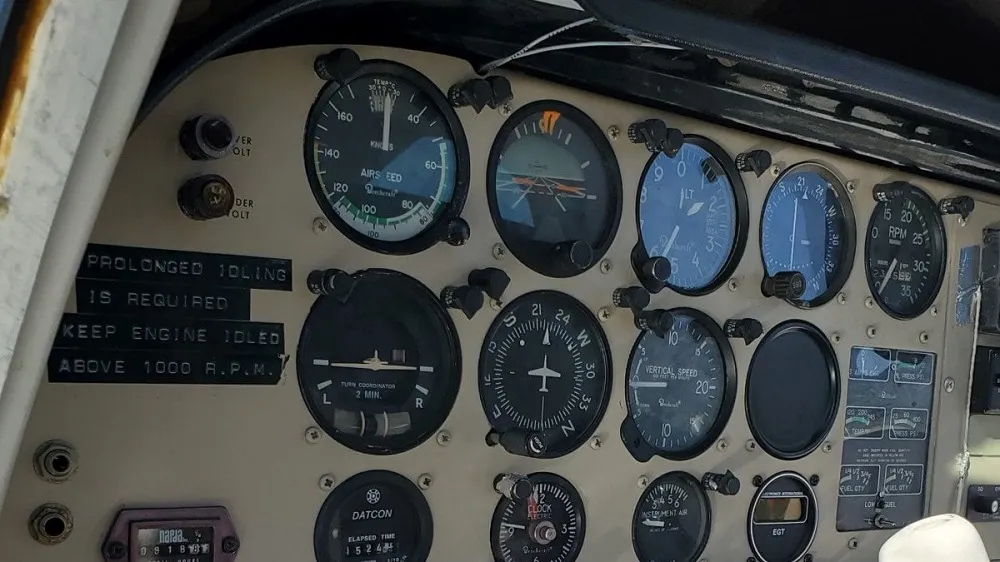Every student pilot eventually hears about the “six pack”, but we’re not talking about abs or soda. In aviation, the 6 basic flight instruments make up the core of a pilot’s information system. These tools give you everything you need to safely control the aircraft, navigate, and understand how it’s behaving in flight.
Whether you’re flying in clear skies or through thick clouds, mastering these 6 pack flight instruments is critical. They don’t just show data; they help you make life-saving decisions.
Let’s take a deep dive into each of the six pack instruments, how they work, and why they matter.
What Is the Airplane Six Pack?
The airplane six pack refers to the six main flight instruments found on most general aviation aircraft. These gauges are typically arranged in two rows of three and provide vital information about the aircraft’s motion, orientation, and speed.
Here’s a quick overview of each one:
Top row (attitude and motion):
- Airspeed Indicator
- Attitude Indicator
- Altimeter
Bottom row (turn and trend):
- Turn Coordinator
- Heading Indicator (Directional Gyro)
- Vertical Speed Indicator (VSI)

These instruments are part of nearly every primary training aircraft, and they lay the foundation for more advanced avionics and digital displays. Even glass cockpits rely on the same core data.
1. Airspeed Indicator (ASI)
Function: Measures how fast you’re moving through the air
Unit: Knots (nautical miles per hour)
The airspeed indicator uses pitot-static pressure to calculate your speed relative to the surrounding air. It’s color-coded for safety:
- White arc: Flap operating range
- Green arc: Normal operating range
- Yellow arc: Caution range
- Red line: Never exceed speed (Vne)
Understanding your airspeed is crucial for everything from takeoff to stall prevention. A low reading could indicate you’re approaching a stall. Too high, and you’re risking structural failure.
2. Attitude Indicator
Function: Shows the airplane’s orientation relative to the horizon
This gyroscopic instrument helps you understand if the airplane’s nose is pitched up or down, and if the wings are level. It’s vital in low visibility or instrument flight conditions.
- The background is divided into sky (blue) and ground (brown)
- A miniature airplane and horizon bar show your position
- Bank angle lines help estimate your turn rate
The attitude indicator is often considered the pilot’s best friend during IFR flying or unusual attitude recovery.
3. Altimeter
Function: Measures altitude above sea level
Unit: Feet
The altimeter works by comparing static pressure from outside the airplane to a sealed pressure capsule inside the instrument. You must set the correct pressure setting (called the altimeter setting) before flight and adjust it en route.
- One short, thick hand: Thousands of feet
- One long hand: Hundreds of feet
- One very thin hand: Tens of thousands of feet (in some models)
Reading an altimeter accurately helps maintain safe vertical separation and comply with airspace requirements.
4. Turn Coordinator
Function: Indicates the rate of turn and quality of coordination
This is a dual-purpose instrument:
- Miniature airplane or symbolic aircraft shows rate of turn (standard rate = 2 minutes for a full 360)
- Inclinometer (ball in a tube) shows coordination (slip or skid)
If the ball is centered, your turn is coordinated. If it drifts to one side, you’re slipping or skidding, something you’ll feel during flight but need to correct for safe, efficient maneuvering.
Turn coordinators are powered by electricity in most aircraft, offering redundancy if the vacuum system fails.
5. Heading Indicator (Directional Gyro)
Function: Displays your aircraft’s heading
Unlike the magnetic compass, which can swing and lag, the heading indicator provides a stable and accurate reference. It’s gyroscopic, so it must be periodically realigned with the magnetic compass (usually every 15 minutes).
The heading indicator is especially helpful during maneuvers, cross-country flying, and when tracking compass headings in turbulence or during IFR flight.
Related: What Is Pilotage and Dead Reckoning?
6. Vertical Speed Indicator (VSI)
Function: Shows the rate at which the aircraft is climbing or descending
Unit: Feet per minute (fpm)
The VSI works using pressure changes in the static system, with a calibrated leak that measures how fast pressure is increasing or decreasing. It responds with a slight lag but provides useful trend information.
- Climb: Needle moves up
- Descent: Needle moves down
- Level flight: Needle rests at zero
A smooth, steady VSI is a sign of stabilized flight, which is essential for passenger comfort and efficient fuel use.
Pitot-Static vs. Gyroscopic Instruments
The 6 pack instruments are powered in two different ways:
Pitot-Static System
Used by:
- Airspeed Indicator
- Altimeter
- VSI
These instruments rely on outside air pressure. Blockages (like ice or bugs) can cause incorrect readings, which is why preflight checks are so important.
Gyroscopic System
Used by:
- Attitude Indicator
- Heading Indicator
- Turn Coordinator (electrically driven in many cases)
Gyros can be powered by a vacuum pump, electrical system, or both. Knowing your aircraft’s setup helps you understand how a failure might affect instrument readings.
Why the Six Pack Still Matters
Even with modern glass cockpits, these six core instruments remain the foundation of pilot training. Most electronic flight displays replicate the six pack layout to maintain familiarity and safety.
Learning how to read and interpret the six pack instruments helps you develop essential situational awareness. Whether you’re training VFR or IFR, these instruments will always be with you, sometimes physically, sometimes digitally.
Tips for Learning the 6 Flight Instruments
- Start with the big picture: Understand what each instrument does before worrying about numbers.
- Group them mentally: Top row = orientation, bottom row = motion and trend.
- Practice scanning: Develop a smooth instrument scan pattern to stay ahead of the aircraft.
- Use simulators: Many free or affordable flight simulators offer realistic six pack training.
- Ask your CFI for visual tricks: Instructors often have helpful analogies to make things click.
Related: How to Pick a Flight School
Final Thoughts
The 6 basic flight instruments form the heart of every flight. By understanding the airplane 6 pack, you’ll build a foundation that will carry you through every phase of your training and beyond.
These aren’t just tools; they’re lifelines. When things get bumpy or the weather turns, your ability to interpret these six gauges is what keeps you in control. Learn them well, practice often, and keep scanning.
Recent Posts
FAA MOSAIC Final Rule: What Pilots, Manufacturers, and the Aviation Community Need to Know
Learn how the FAA’s MOSAIC final rule revolutionizes Light-Sport Aircraft certification, expands Sport Pilot privileges, and reshapes general aviation. See what’s changing, when it takes effect,...
Student Pilot Insurance: Essential Coverage for Aspiring Flyers
Discover how student pilot insurance can protect your flying dreams. Get expert tips and coverage options to ensure your safety and peace of mind.


